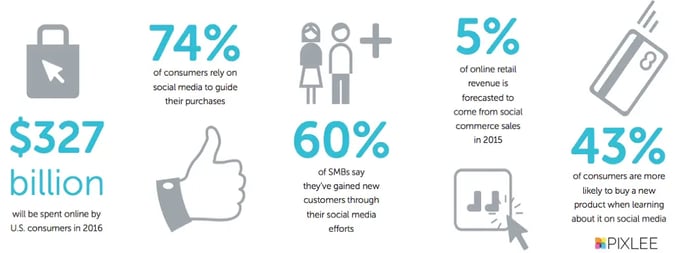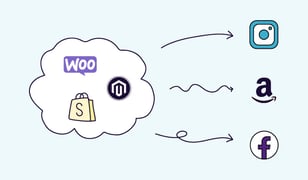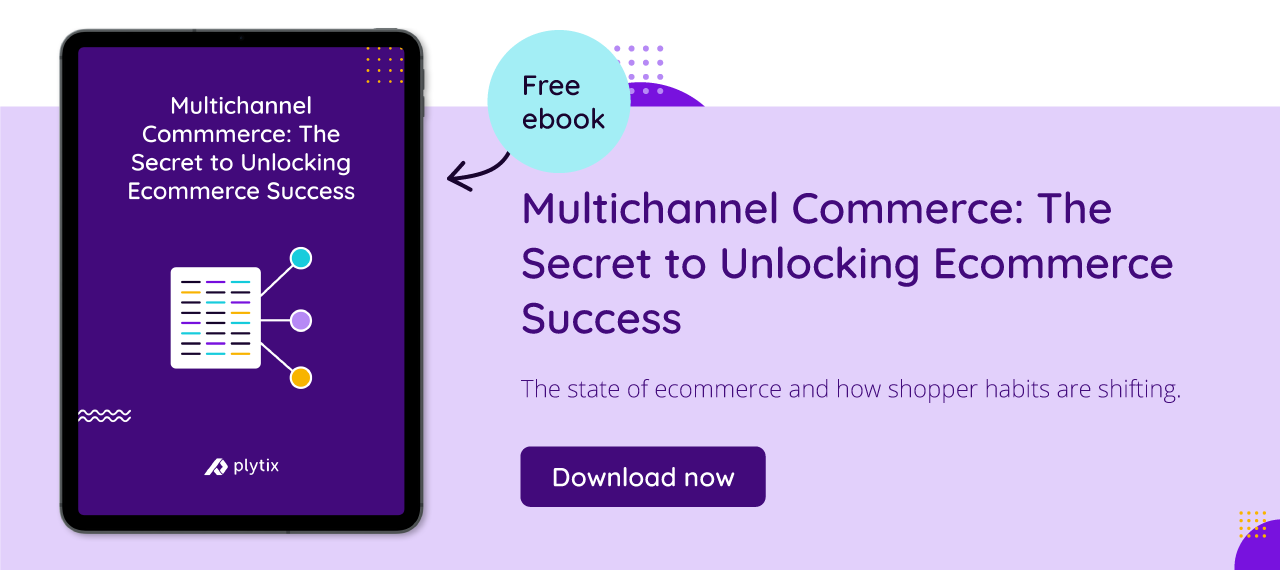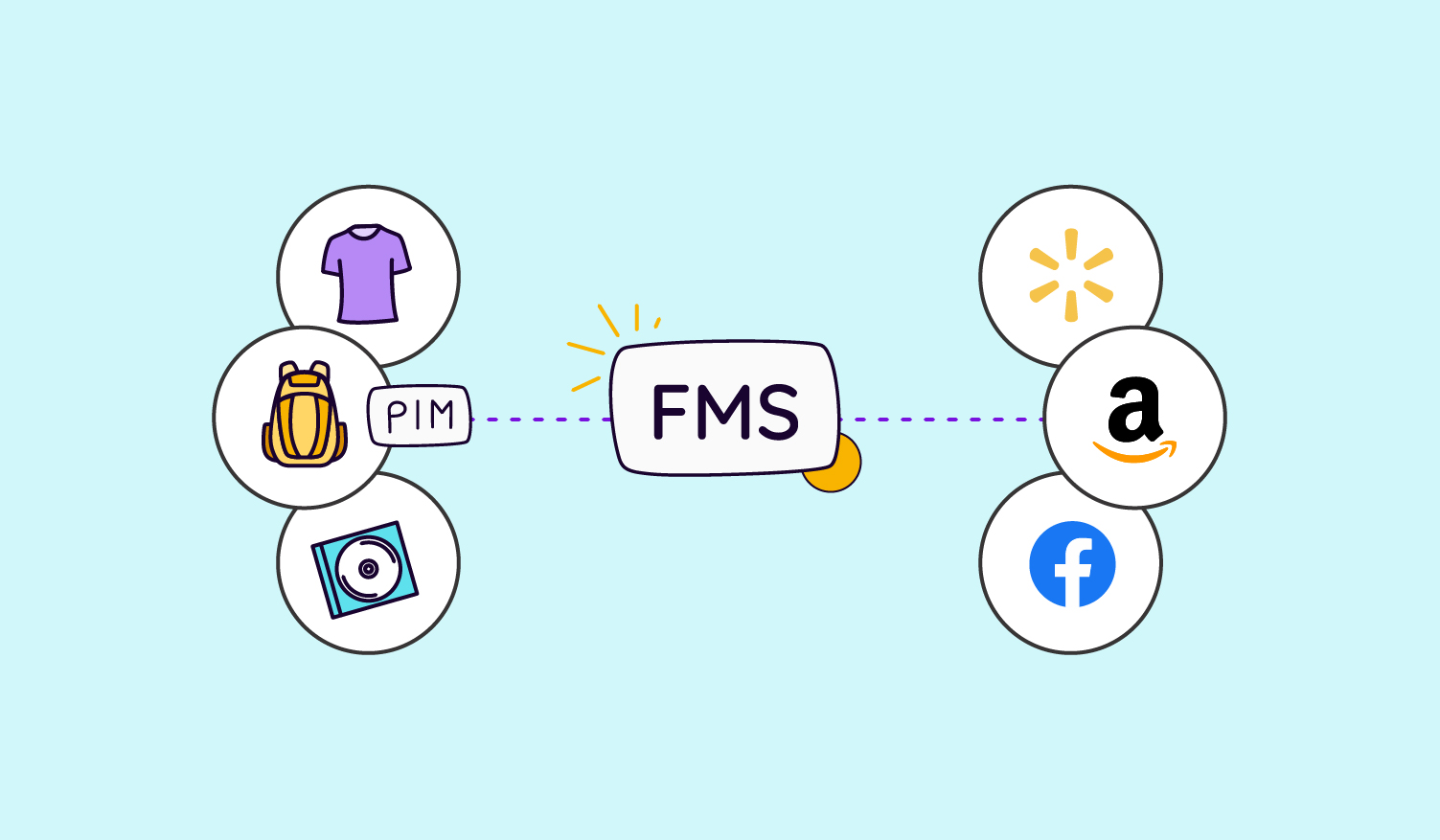So, you’ve finally decided that you’re going to implement a multichannel selling strategy for your business, or you’re simply doing more research on whether this is the right move for you. Either way, when you do decide to do multichannel selling, this is a significant next step for your business as it opens the door to many online opportunities.
Selling on multiple sales channels helps businesses increase their visibility, reach a wider audience, meet customers where they are, and increase customer satisfaction. Sounds impressive, right? But before you jump into creating a multichannel strategy, it’s essential to know what ecommerce sales channels there are and which is best for your business.
In this article, we will look into what we mean by sales channel, the different types of sales channels, and the best tips for determining which sales channels are a good fit for your business.
What are sales channels?
Sales channels are methods an organization uses to sell its product or service to customers. They can either sell through one single platform (like you may be doing right now) or they can sell through a variety of channels to meet more customers and drive more sales.
Types of sales channels for ecommerce
Here are five important ecommerce channels you should consider for your business:
1. Ecommerce platforms
Ecommerce platforms (or webshop systems) are platforms where you can sell your products directly to your customers. This is the main website for your store. As an ecommerce business, you can sell your products through ecommerce platforms such as Shopify, BigCommerce, or WooCommerce. Selling products or services directly from your own webshop has grown in popularity in the last few years—with revenue in the ecommerce market projected to reach US$4.48tn this year. What’s more is, it’s expected to have an annual growth rate of 9.30%, resulting in a projected market volume of US$6.39tn by 2027.
Pros
- There are lower set-up and running costs compared to a physical store
- Businesses can sell from anywhere, bringing in more sales opportunities
- You can always make sales as online stores are active 24/7
Cons
- First-time customers have a hard time trusting online shops
- Customers can't physically shop which can lead to more returns
- Inefficient distribution channels can affect the customer experience as customers expect fast delivery times (from 1-3 hours after shopping to same-day shipping)
2. Marketplaces
Marketplaces are platforms that connect multiple sellers with potential buyers. Many customers shopping on marketplaces since it acts as a one-stop shop where they can purchase products in different categories (such as electronics, jewelry, and home appliances). A study found that 50% of power shoppers (people who value their time and dislike shopping) do their shopping through marketplaces. On top of that, 83% of power shoppers say it’s a convenient way to shop as they can get everything they need in one place and it has better delivery options.
With marketplaces, there are different options for different businesses. There are:
- General marketplaces like Amazon and Walmart.com
- Auction marketplaces like eBay and Atomic Mall
- Crafts marketplaces like Etsy and Amazon Handmade
- Niche marketplaces like Airbnb and Booking.com
- B2B marketplaces like Amazon Business and Alibaba
Note: It’s important to choose a marketplace that fit your business niche and goals so that you can find your target audience easily. But we’ll expand more on this later.
Pros
- You reach a bigger audience that already trusts the platform
- They have efficient distribution channels
- You can increase brand awareness which can bring traffic to your store
Cons
- There is higher competition in marketplaces so you need to rank well
- Marketplaces charge vendors high commission
- They have specific requirements you need to adhere to
3. Social commerce
Social commerce has seen crazy growth over the last few years as many customers enjoy the perks of shopping while on social media. Businesses can sell to customers on Facebook, Instagram, TikTok, and Pinterest. It’s a beneficial sales channel for businesses as more people are joining social media platforms every day. It can improve brand awareness, bring in referral sales, and drive more traffic to your website which ultimately leads to sales.

Pros
- You can get in direct contact with potential customers
- Social proof is easier on social channels as customers are always commenting, liking, and sharing
- Your social profile helps build your brand and image
Cons
- It’s time-consuming as you have to create more visual content and engage with followers
- You need do more paid social to get more sales as organic reach is harder
- There is a higher chance for negative feedback which can ruin your brand's image
4. Comparison shopping sites
Comparison shopping sites (CSEs) gather information about products from various websites and compare them against one another. This type of sales channel is ideal for customers who like to shop around for discounted prices or simply want to compare prices before they make a purchase. Popular CSEs are Google Shopping, Shopping.com, and PriceGrabber.
Pros
- CSEs can bring in more sales by reaching a bigger audience
- You can engage new customers that shop on the CSEs
- You can compete easily with your competitors—showing off your competitive edge
Cons
- They charge a set fee for every pay-per-click-through or a percentage of the completed transaction will go to them
- This won’t necessarily create brand loyalty as these customers are looking for deals and may not come back to your brand
- Cart abandonment can be an issue if customers find a better offer or are surprised by unexpected costs (such as delivery fees)
5. Daily deals sites
Daily deals sites gather information about promotions across the internet. It is similar to comparison shopping sites as they both target customers who are looking to shop for products at a discounted rate. To have your products on these sites, you may need a subscription fee or pay a portion of sales from a customer clicking on their link. This is ideal for businesses that want to promote their sales. It can be a great place to incentivize customers to buy slow-selling products. Popular daily deals sites are Rakuten, Amazon (Deal of the Day page), and Groupon.
Pros
- You increase your reach and promote your sales to new discount-hungry customers
- Most sites have no upfront costs for signing up (be sure to read the terms and conditions)
- You can use these deals to help create brand awareness and build customer loyalty
Cons
- This might not be as lucrative as other sales channels since you’re selling your product/service at a discount
- There are no guaranteed sales even with the discounted price
- Customers may not want to purchase items at full price with your brand later on
How to determine the right sales channel for you
Now that you know which retail sales channels are out there, you may be wondering, “Should I use all these different sales channels to succeed in multichannel selling?” But, before you run for the hills after seeing all of these different channels, know that you don’t have to take on all these retail channels. It’s all about choosing the right ones that make sense for your business—the ones that can get your products to where your ideal customers are.
Here we’ll give you tips on determining the right sales channel for your company.
1. Consider the type of product you’re selling
Knowing the type of product you sell is important in understanding what sales channels your customers shop on. For instance, if you’re selling handmade craft items, it may be tempting to sell through Amazon because of its popularity. But you have a niche customer base, so you'll get more sales opportunities on a crafts marketplace (such as Etsy) as most of your target audience is there.
2. Evaluate your market
Thinking about who makes up your target market is crucial. So, ask yourself:
- Are you selling to consumers or other businesses?
- Do they prefer to purchase from a brick-and-mortar store, website, marketplace, or social media?
- Would you need to work with retailers to sell your product?
These questions can tell you if you should be selling on Amazon Business, renting a space in a mall, considering a pop-up store, or focusing all your energy on social commerce.
3. Think about your competitors
While every business would love to believe that customers prefer their product over their competitors, that isn’t always true. But you can use your competitors to improve your business. So, take time to look at their multichannel strategy and see where they are selling, as there is a high chance that that is where your customers are.
But, looking at your competitors won’t just help you find your customers; it can also help you gain a competitive advantage as you can see the gaps in their strategy. You'll be the first to sell on the sale channels they forgot about. For example, they may have an ecommerce website and sell through Esty. You can do that too, but you can also add Amazon Handmade to your strategy to find other customers who are looking for handcrafted home decor, jewelry, accessories, and more.
4. Ask yourself if it makes financial sense
Sales channels for small businesses can be a great way to make more sales, but there are still costs involved. For instance, when you choose to sell through marketplaces, you have to consider the cons, such as the commission you have to pay for every sale made using their platform. It may be best to have your ecommerce website and sell on social media. Or, it may be best to have a DTC strategy or only sell through a marketplace. Carefully weigh your options before committing to anything.
Make sure you check if the sales channel has selling, storage, or fulfillment fees. And if they do, calculate the profitability for your business so you know if that sales channel is worth it or not.
5. Be realistic about your efforts
The idea of being wherever your customers are sounds nice because of the potential sales it could bring in as well as the increased brand and product visibility. But it’s vital that you are realistic about your efforts because it can be a lot to take on.
For instance, opening an ecommerce store means you need to up your game and ensure you have high-quality digital assets that showcase your product in its real form. Moreover, you need to have error-free and informative product information to ensure your product titles and descriptions tell a customer everything they need to know.
Remember, unlike a brick-and-mortar store, customers cannot come and observe a product before purchasing it. They depend on the information you give them, and if it’s incorrect and they don’t get what they want, you’re stuck with unhappy customers and possibly lots of returns to deal with. If you want to open an ecommerce store, be realistic about your efforts and what you may need to succeed.
6. Be open to growing
It’s always best to start small in the beginning so that you can focus on one channel at a time, but always have the plan to grow. Customers are always evolving and shopping wherever they think is best, and it’s important to keep up to ensure you’re reaping the benefits of multichannel selling.
So, keep up with your market and competitors to see where you can grow your business. And when the time is right, consider adding tools that make scalability possible such as a PIM, DAM tool, and feed management system. These tools will help you manage your product information and media so that you can streamline your processes. Updating, optimizing, and sharing your product information manually from spreadsheets can hinder your productivity and create unnecessary errors. And, that's the last thing you need when you're trying to expand your business.
Final thoughts
We know that this may be a lot to take in, but we’re here to tell you that having a successful multichannel strategy is doable. There are different ecommerce sales channels to choose from, so take the time to sort out what makes sense for you and begin adding new channels in when the time is right. There are many stores that are killing it in multichannel commerce and that could be you too!
If you wish to read more about multichannel commerce, you can download our free eBook on multichannel and the secret to success.





